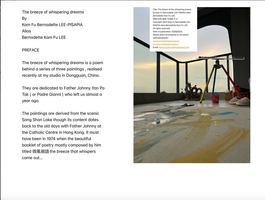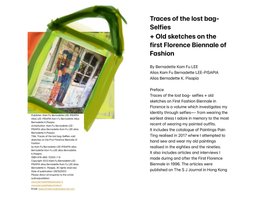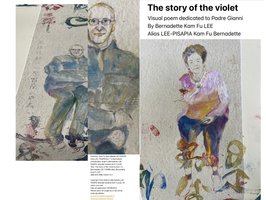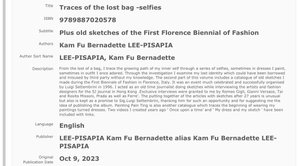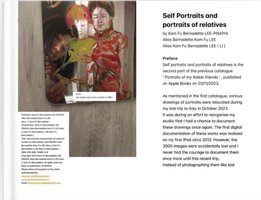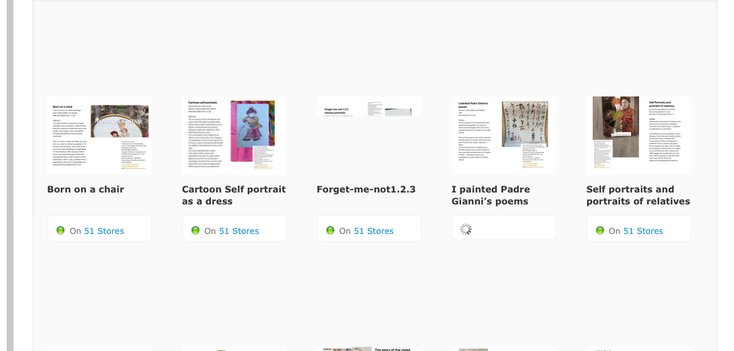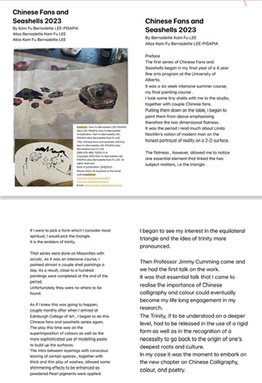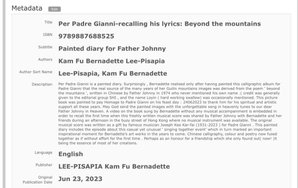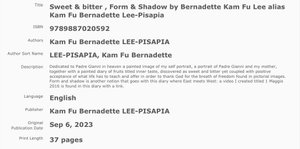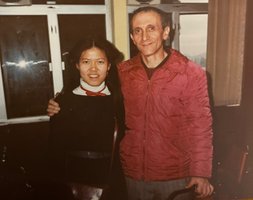BERNADETTE , known as
Bernadette Kam Fu LEE
as well as Kam Fu Bernadette LEE-PISAPIA , A FINE ARTIST and a Self-published author
Art , not for sale except for prints and artist books solely handled by Laboratorio Fratelli Manfredi.( previously known as Mavida)
Bernadette does not sell her pieces since her retrospective in Florence ( 1983-1993, Grande Quadri. Quadri Invendibili)
whoever sells you works by Bernadette after that date could be of stolen pieces.
Kindly inform Bernadette via email: leekamfubernadette@pec.it
Bernadette’s diary-
37th book on Apple Books for free reading:
The dream of the whispering breeze ( The breeze of the whispering dreams)
10/06/2024
ISBN 978-988-70365-2-4
39th volume: Dongguan, my father's hometown, published 19/09/2024
My Guilin 2024 is a new form of autobiography: a summary of my artistic diary form the past, present and the future
5 August 2024 is a video I realised on ' My trip to Venice' which covers the Venice Biennale 2024 -" Foreigners everywhere'- and the exhibition on De Kooning L'talia ( Gallerie dell'Accademia di Venezia)
photos 40 years later:
with Padre Gianni in Dec 1983, Hong Kong
with Don Italo. Mazzano Romano, Oct 2023
on Apple Books
for free reading
under author:
Last name: LEE-PISAPIA
first name: Kam Fu Bernadette
LEE-PISAPIA Kam Fu Bernadette or LEE Kam Fu Bernadette
( order of name used in Hong Kong and Italy
alias
Kam Fu Bernadette LEE-PISAPIA ( alias Kam Fu Bernadette LEE PISAPIA)
(order of name used in Britain, Canada )
alias
Bernadette Kam Fu LEE ( maiden name)(artist name)
LEE-PISAPIA, Kam Fu Bernadette
(order and form ( with a comma in between ) generally used in Hong Kong to distinguish
last name from first name)
Kam Fu Bernadette LEE-PISAPIA
(order generally used in Britain and Canada )
penname: Bernadette K. Pisapia, Kam Fu Pisapia, Lee-Pisapia Kam Fu Bernadette
Bernadette is the writer as well as the publisher
the name chosen for the publisher ( not a registered company ) has two
formats:
LEE-PISAPIA, Kam Fu Bernadette ( Hong Kong format), or LEE-PISAPIA Kam Fu Bernadette ( Italian format) . Therefore, the comma in between does not mean two distinct individuals as it is used to distinguish the last name and the first name in the Hong Kong format. For the other format, capital letter has been used to indicate the LAST NAME from the first name.
( from 06/09/2023, the Italain format is officially transformed to LEE Kam Fu Bernadette coniugata PISAPIA . However, the fully extended writing of my hyphenated Last Name is still maintained as my Canadian and Hong Kong identity : Kam Fu Bernadette LEE-PISAPIA)
NOTE:
email : ahfu@bernadetteleepisapia.it has previously been compromised and therefore please use the email:
kamfubernadette@icloud.com or leekamfubernadette@gmail.com to contact me.
Thank you.
Bernadette
05/05/2023
Hong Kong
student name used in Italy:
LI (last name)
Kam Fu Bernadette ( first name)
videos Per Padre Gianni can be viewed on my other website:www.bernadetteleepisapia.it especially realised by Bernadette for the family of Padre Gianni in Mazzano Romano and Capranica, Italy, thanking them for their hospitality
Teaching philosophy
Teaching Philosophy
When I was a student , I was keen on understanding how creativity would be the most important element which underlies a piece of Art work.
That question continues until thirty years later, when I am a practicing artist.
Strangely enough, the most creative source I came to discover in the course of research on creativity lies within myself- that innate source was left unattended for sometime due to an oversight.
It then dawned on me that the most beautiful things made are those acts performed without a too rational intent, such as the natural bloom of a flower, and the natural consequence of the fall of a mature fruit.
To be a painter or not to be a painter is not important. To be able to paint as the natural birth of a fruit is poetic.
Thus, this zen way of seeing pacifies my suffering period of no production, with a result of seeing creativity with an inner understanding.
I intend to create painting, installation, video diaries, illustration with years of practical knowledge turned intuitive.
Like the most beautiful zen lesson of no mind, a constant practice with dedication would naturally lead to an intuitive grasp of knowledge beyond one’s limit— the teaching of being oneself with the maximum result—a spiritual self-conquest.
Bernadette Kam Fu Lee
Viale Caduti in Guerra 23
Castelnuovo di Porto
00060 Rome
Italy
Teaching Experience
summary of my teaching experience
from 1983 to 1988
Florence, Italy
As a fresh graduate just came out from the postgraduate program in Drawing and Painting ( Edinburgh College of Art 1982-83 ), I went to Florence, Italy and began my first teaching experience.
At Fortman Studios, where I was initially invited to teach beginning Painting, and later took on a more responsible role as instructor in intermediate and advanced level, I applied seriously what I had learned previously and shared it with all the students I came to meet from all over the world.
At that time, I was researching on the interaction between western tradition of colour as a pictorial language and eastern tradition of Chinese calligraphy as a personal expression, which led to a series of works inspired from both, with the predominant character of Poetic atmosphere as a deliberate underlying element.
Due to such nature of research, it was definitely inspiring to meet artists from all over the world at Fortman Studios who went there in order to have a glimpse of historical past of western painting tradition, which has its origin in Giotto.
For that reasons, I was so eager to share what I had just learned from my western training at the University of Alberta, where I had very good professors who taught me colour, and the drawing tradition which I learned from the reputable Edinburgh College of Art, where I spent one year as a visiting student, and another year as a postgraduate student.
Due to the introduction of drawing tradition at Edinburgh College of Art, I was able to re-examine the idea of lines, innate in the Chinese tradition of Calligraphy, as well as the essence found in the tradition of Abstract expressionism, which began with Pollock.
Such a mixture of approach was fulfilling due to my early exposure with the Art of Chinese Calligraphy when I was a child in Hong Kong. To situate myself in Florence, Italy, and be challenged with the whole patrimony of western pictorial tradition, I was humbled as well as constantly inspired.
It is as if I was given the codes to enter both worlds ( mine with my own tradition) and the other with the richness of the past, conserved and reanimated right in front of me, at the City of Florence where the sense of Renaissance spatial understanding was still present in every corner of the town.
The controversy and the refusal to just copy the past, but live with the present with one’s own culture, yet learn from the others was stimulating. How to live in a very traditionally established city with its own cultural roots without losing one’s own identities was inspiring. It was also this particular reason why I decided to develop this research -Chinese calligraphy, western colour, and poetry in a city not my own, but a totally different one culture wise.
Because what I had understood at the time of such decision of choosing Florence among all other cities in the world to embark such a mission was precisely this:
1. one could not appreciate one’s own spiritual force without a confrontation, especially when the other culture is totally opposite in its approach ( in this case, rational vs intuitive)
- one could only give to the others if one is true to one’s own cultural roots ( especially one’s innate source of expression- in my case, the art of Chinese calligraphy)
- how to tie in both cultures without losing any, or at least without trying to ignore one’s own roots while passionately learning from the others
Due to all these conditions I set for myself behind the research, I was so eager to teach my students at Fortman Studios.
When a student happened to run into a pictorial problem, I would internally digest it to the point that I would become the student myself, in order to suggest various solutions to the proposed problem.
To do this, one has to be humbled in the first place, and secondly, to be able to comprehend that process of learning - from the inevitable problem of putting together sight, hand, and mind to the technical one. The technical problem was not a big issue as one could easily overcome with the time, but to be able to allow the student to put all she or he learned with practice, the teacher has to be like a beginning student in order to comprehend what is lacking and why a certain problem exists.
I must say I was particular good at solving such issues as I was once again enrolled at the Academia di Belle Arti di Firenze, as a full time student again.
I still remember I was a student in the morning, and in the afternoon a teacher. On several occasions, I had even trouble in remembering my roles- am I a student or am I a teacher?
The pictorial problem was there for me to solve, either in the morning as a student, or in the afternoon as a teacher.
I entertained myself and my students a great deal being that way.
Thus my stay at Fortman Studios was a pleasant one.
Teaching at the Uffizi
Then at one point, Fortman Studios had introduced me an extra job, by allowing me to teach a semester at School in Italy , Middlebury College. It was an individual project. The student wished to do some drawings based on the Primavera of Botticelli. Instead of suggesting her to continue her project by copying from printed works of Botticelli, I told her that we would spend lessons at the Uffizi, right in front of the work of Botticelli.
The idea was that most foreign students who came to live in Florence somehow miss the points: instead of learning from original works as all masters have done in the past, they tend to learn from slides or printed material.
So the inspiring atmosphere to be able to see Botticelli live with the student was a memorable experience.
A second offer by the same College the next year allowed me to also teach an individual student at a private studio. It was a pleasure to be ale to follow a student at a higher level so we could share some intriguing elements regarding pictorial creation, which does not happen with beginning students
intensive workshops on drawing/ painting 1984
In the summer of 1984, after having taught two semesters at Fortman, I was proposed to take over the studio for the summer and experienced the first time of having a workshop run on my own.
I designed two courses, both intensive, one conducted in the morning , and one in the afternoon.
The morning session was painting, which lasted six hours, with intensive projects that I had designed in order to question the intrinsic problem of spatial construction regarding colours.
The afternoon session was drawing, which lasted six hours, with intensive projects that I had designed in order to re-examine the intrinsic problem of spatial construction with the use of lines.
Thus the courses were titled: Colour with Space
Drawing with Space
As a passionate researcher in pictorial problem at the time, I had come to the conclusion if such idea of spatial construction was re-examined through constructive projects, the student would be able to have the necessary foundation to develop his or her own pictorial creation with greater freedom.
These courses were not arbitrary as I had done the projects myself since most projects were given to me when I was a student in Canada.
Furthermore, some notes made by an artist at my University in Canada were also used as a source for group critiques, which was one of the highlight of the course.
The students I had came all over the world, and I still treasure those group critiques we shared with one another.
The occasional teaching at Fortman Studios, with more or less two or three afternoons each week became a constant source of inspiration, both for my art work as well as my teaching experience.
I enjoyed it a great deal.
At one point, however, I had to depart for Canada as my family decided to move over there.
So I ventured to propose to have some teaching experience in Canada.
Art Gallery of Ontario
Initially I had decided to teach the foundation- the concept of lines and space to the students who came to join the evening sessions I taught, but since I was in Canada and my students were solely Canadian, I had decided to share something that those students would not be able to learn normally in a Canadian Art class: the observational approach in drawing.
To be able to carefully observe the subject matter, be it still-life or life drawing, training is necessary. The longer hours in British way of teaching drawing allows the students to see the subject matter in a way different from the North American training.
For the same reason, the intensive workshop I conducted in Florence was of a duration that lasted six hours each, without break.
The insistence on the length means one thing: that we need time to better the coordination regarding: sight, hand, and mind.
1989-1996, occasional teaching in Fortman
In 1989, after 4 years of doing my Painting full time program at the Academia di Belle Arti, I graduated with a thesis on Zen and Marcel Duchamp.
The idea was to be challenged by a rational approach, with Duchamp being the expert, and an intuitive zen approach, which is its opposite.
The fusion was natural as I had come to Florence, a city with rational pictorial tradition to embark on the expressive approach of eastern calligraphic tradition, which is purely intuitive.
And yet, it was more than intuitive as we have often heard, that intuition is only made possible once the artist is one with the artwork, in the sense that the work is done almost selflessly, created by itself, so much so that the artist is surprised at that spiritual touch, as if done by Heavenly force, not his or her own.
Such moments of spiritual union with oneself could be made possible in two ways: one is a gradual dedication which leads to enlightenment, as a natural consequence
another is a sudden realisation due to external and internal pressure which results all of a sudden as a spiritual awakening: the conquest of oneself which leads to a work free from traditions, limits — pure creation of no mind, which, for the Orientals, is the greatest achievement one could ever attain in one’s life time.
After that thesis on Duchamp, I was caught between the intuitive ideal and the intellectual solution initiated and difficult to be ignored by Duchamp.
I went back to Fortman to teach occasionally and offered some free lessons when the Studios had difficulties in getting students.
Zen approach
Then time came that I decided to found an Art Association. So an Association named Est Ovest was established in Florence.
I decided to conduct some zen painting workshops.
In order to continue my research on spontaneous creativity, I designed courses that would need the use of ink and brush, in the oriental manner, yet different from the traditional oriental approach.
As the Association is situated in the centre of Florence, with a garden, I designed the courses so that the subject matter would be nature- usually plants, trees or flowers that are in the garden.
Upon meditating on the subject matter , the participants are asked to express themselves through a series of quick sketches, done on rice paper with ink. Such ways of expression were not based on direct observation, but on internal observation—often times poems were asked to be written by the participants, and then are encouraged to trace that poetic feelings onto the difficult to manage rice paper with ink, after having meditated the subject matter some minutes before.
The idea is to allow oneself to see creations made without much control, though the control was done with poetic intention- one follows what one truly feels poetically instead of what one sees correctly.
Such workshops allowed me to practice this inner memory approach with poetic mind myself, which led to my second stage of developing my works towards the oriental understanding of no mind.
Back to Canada, inspired by Native Art
The Art Association had somehow come to a full stop, when I had to return to Canada in 2001.
In 2002, I ventured in Northern Canada, became a professor at an Art Academy where most students were natives.
I was given the role of teaching foundation studies, Business of Art and seminars.
As someone who had gone through western and rational training in the pictorial field, I had found the meeting with native culture an incredible challenge.
I had in front of me a rich patrimony to learn from: the native students did everything handmade- so beautifully.
I had nothing to teach.
So my only concern was to inspire and to allow them to fulfil and not to forget their own roots of culture, which is so rarely seen in the contemporary art world.
Realisation of oneself is not necessarily found in one way, in one tradition. That is the very basic of artistic creation.
So instead of teaching rational means of understanding pictorial space, I was taught to see the solution regarding creativity in a new dimension.
2003-2017
In 2003, I went back to Italy and bought a studio space in Rome couple years later.
I began to work on more abstract paintings as if the search for a full statement: western tradition in colour, Chinese calligraphy tradition, and poetic means had to be restated in a new setting—the setting of a garden.
The studio space I bought came with a huge garden, where I was able to paint big again, and with brush works borrowed from the movement made by the trees, plants or flowers found in the garden.
But somehow, something was happening and I ceased to produce works.
Maybe I was very Duchampian in the sense of non production. But maybe it was also an excuse.
Then all of a sudden, I came to recall my childhood, which was very happily lived.
The lost of memory became the re-conquest of such as a means of creativity.
I had no more excuse.
I picked up the left over watercolour and with a brush, not quite refined due to its age, did a whole series of drawings : Self portraits in a dress.
To return to my inner self , I no longer needed the external factors such as a garden, or a landscape. I had my own memory as creative source.
To my surprise, I became well, happy and joyful right after I had reconciled myself, by allowing myself to be less intellectual, and even up to a point of forgetting about whether I should continue the research on Chinese calligraphy,western colour, and poetry.
Then one day, after having bought some pillars to be placed in the garden for quite sometime, I began to install them as if they are gigantic pencils, by painting the sharper ends in various colours.
Then I began to write on the pillars some old Chinese poems.
From that installation, some other poems were written on re-gathered wooden frames, tied together to form objects that recalled further old Chinese poems.
One installation leads to the next, then the whole garden became filled with points of poetic situations, which reminded me of my youth where I spent much time composing and reciting favourite Chinese poems.
The calligraphic poems written on those pieces were in colour, and in that natural settings, among old trees, broken branches, blooming flowers, a new mood is staged.
Those settings allowed me to re-make a new platform- allowing my garden to embrace my paintings over the last thirty years, which had its source in Chinese calligraphy, western colour and poetry.
To stage therefore a new platform-installing all the paintings and stage them in such a way that each corner would suggest a different kind of poetic source.
That platform, however, lasted one day.
No audience was invited. But a record of how I staged my works remain.
It turned into a book, self published in a single volume, titled As in a Dream.
As in a Dream, all these years of living in Italy, as a painter, poet, and teacher who does not quite know how to put the opposites together- the intuitive and the rational, but somehow manages to reconcile with herself in a dreamy setting- the going back in time, the reconciliation with one self.
Back to College, August
After having lived in Italy for thirty three years, I finally gave myself a gift, to go to London and become a student again, even for twelve days, at the Royal College of Art.
I chose the Royal College of Art for many reasons. But one of them was to be reminded of my first year as a painting student in Canada. My professor was from the Royal College of Art.
I still remember he told me not to forget what I know best—my calligraphic mark which is oriental.
His famous discourse was: how to paint the essence of an orange.
At the Royal College of Art, I became a student so much so that I had lived that experience intensively; by seeing and annotating my every minute experience as a miracle, due to my happy years spent as a student and as a teacher in Florence.
I decided also to challenge myself by doing something I had never done before : using films I used to love when I was a teenager in Hong Kong as a departure point
It was my way of sharing with other students by suggesting a youthful way of seeing , or a raw way of treating material so much so that each process became a transparent recognition.
The difference between someone who has gone through various stages and a young student is that the latter does not see transitions as clearly.
I, in order to contribute to the community where I was invited to participate, wished to make my transitions transparent.
How I came to put them together, and how I decided all mistakes were meaningful, was a conscious contribution I made to the class, whose average age was thirty years younger.
By not hiding one’s mistakes, and by allowing others to be the protagonists, was what I thought meaningful about my stay during that period.
Therefore, the use of a medium which I was of no expert- watercolour was a challenge I gave myself.
It was watercolour that saved my depressive period of non production, and therefore, it was natural of me to use it in a country where watercolour is the best known medium in their pictorial tradition.
It was a thankful way of saying, here I am, painting again, thank you watercolour.
The non hiding mistakes process required from a watercolour practitioner, at this point, is a way of readdressing the previous research on the combination of Chinese calligraphy and western colour tradition— but now in a conscious yet not contrived recognition of the problem.
I had never thought the much research over the last years was an oversight on a medium which intrinsically has put the two elements together seamlessly.
The Future- about teaching
Not having taught for some years, yet am so eager to share how I learned and grew with the process of creativity, I decided to make that transparent over my websites.
Thus I update my websites constantly in order to trace my understanding of creative process, which is what makes art teaching interesting.
17/07/2017
by Bernadette Kam Fu Lee
alias Kam Fu Bernadette Lee
alias Bernadette Lee-Pisapia
Condividi questa pagina



